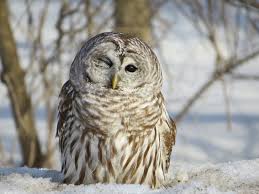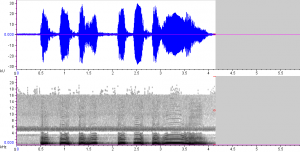When one thinks of an owl, one normally associated it with its classic call: “hoot-hoot”. But have you ever associated an owl with the phrase “Who cooks for you, who cooks for you-all?”

The species Strix Varia, known best by its common name Barred Owl, is a species of owl that, along with typical hoots, has a call of eight or nine notes described by this peculiar mnemonic. Native to the eastern United States and spreading to the Pacific Northwest, this species of bird is known as subscine and nonpasserine; in other words, it does not belong to the family of birds we generally think about when one thinks about songbirds, such as the American Robin, Cardinal, or Chickadees. Likewise, it does not learn songs like typical songbirds, and are rather born with calls innately programmed (Odom and Mennill, 2012).
Generally, there have been a handful of calls associated with Barred Owls, mainly its eight note hoots and its caterwauling in pairs, both of which can be heard below:
Fig. 1 Barred Owl 8-note call
Fig. 2 Barred Owl Caterwauling
http://macaulaylibrary.org/audio/63003/play
These calls are most heard at night or in twilight, and especially during the breeding season. However, calls can be heard year round since these birds do not migrate. They are very territorial, and chase away intruders with loud hoots. These vocalizations become more frequent during the mating season, where female birds make invitation calls to mate with males, or pairs caterwaul.
Some scientists, however, have debated that the calls of Barred Owls are much more diverse than we think. Researchers attempted to catalogue calls in order to show geographic variation in the calls of Barred Owls (Odom and Mennil, 2012). There is clear data that two major clades of Barred Owl live distributed throughout North America: one clade generally resides in the south-central US, whereas those residing on the east coast are considered part of another divergent clade. However, this study found that there were inconsistent vocal variations throughout the two areas, suggesting that the innate vocalizations of this species still contain enormous individual variation, which is expected of non-song-learning bird species.
However, another previous study made by the same researchers noted that there weren’t sufficient nomenclature for the types of calls produced by the Barred Owl, and came up with a list of 13 different vocalizations made by the barred owl (Odom and Mennill, 2010). These calls include everything from typical hoots and ascending/descending calls, allow with gurgles, twittering, and the screaming typically heard in caterwauling but not specifically identified before this. This study also determined that there were different qualities to both female and male calls. Females tended to have a higher pitch and more vibrato (vibrations) in their calls than males did.

Fig. 3 Spectrographs showing 13 vocalizations, one nonvocal sound, and a duet recorded from wild Barred Owls: (A) inspection call, (B) two-phrased hoot, (C) one-phrased hoot, (D) ascending hoot, (e) short ascending hoot, (f) fast ascent, (G) gurgle, (h) two-note, (I) three-note, (J) mumble, (K) twitter, (L) scream (alarm call), (M) female begging, (N) bill snap, and (O) duet. The time scale is standardized so that one tick equals one second. (Odom and Mennill, 2010)
This research indicates that more needs to be known about the Barred Owl before we can deduce more about its behaviors in and out of the breeding season. Owls in general can be a difficult species of bird to study since they are mainly nocturnal and are not incredibly active until the breeding season, but this is a step in the right direction in better understanding these mysterious and interesting creatures.
References
Odom, K.; Mennill, D. (2012). Inconsistent geographic variation in the calls and duets of barred owls (Strix varia) across an area of genetic introgression. The Auk. 129 (3). Retrieved December 9th from http://www.aoucospubs.org/doi/abs/10.1525/auk.2012.11210
Odom, K.; Mennill. D. (2010). A Quantitative Description of the Vocalizations and Vocal Activity of the Barred Owl. The Condor. 112 (3). Retrieved December 10th from http://www.aoucospubs.org/doi/abs/10.1525/auk.2012.11210
Singleton, Peter H.; Lehmkuhl, John F.; Gaines, William L.; Graham, Scott A. (2010). Barred Owl space use and habitat selection in eastern Cascades, Washington. The Journal of Wildlife Management. 74 (2). Retrieved December 11th from http://onlinelibrary.wiley.com/doi/10.2193/2008-548/full
Mazur, Kurt M. and Paul C. James. 2000. Barred Owl (Strix varia), The Birds of North America Online (A. Poole, Ed.). Ithaca: Cornell Lab of Ornithology; Retrieved December 11th from the Birds of North America Online: http://bna.birds.cornell.edu/bna/species/508/articles/introduction
Barred Owl. The Cornell Lab of Ornithology- All About Birds. Retrieved on December 11th from http://www.allaboutbirds.org/guide/barred_owl/lifehistory


